Quality Leadership: Analyzing Nursing-Sensitive Indicators Report
VerifiedAdded on 2023/06/03
|6
|1443
|248
Report
AI Summary
This report explores the significance of nursing-sensitive indicators in enhancing patient care and quality leadership within a hospital setting, particularly in the context of ethical dilemmas. It examines how an understanding of these indicators can aid nurses in identifying potential issues that may compromise patient care, using the scenario of Mr. J to illustrate the practical application of these concepts. The report analyzes how hospital data on specific nursing-sensitive indicators, such as the incidence of pressure ulcers and the prevalence of restraints, can be leveraged to improve patient care throughout the hospital. Furthermore, it delves into the specific system resources, referrals, and colleagues that a nursing shift supervisor can utilize to address ethical concerns arising from the scenario, including the failure to prevent pressure ulcers, the use of restraints, and dietary discrepancies. The conclusion emphasizes the critical role of nursing-sensitive indicators in measuring and improving the quality of patient care, leading to better patient outcomes and satisfaction.
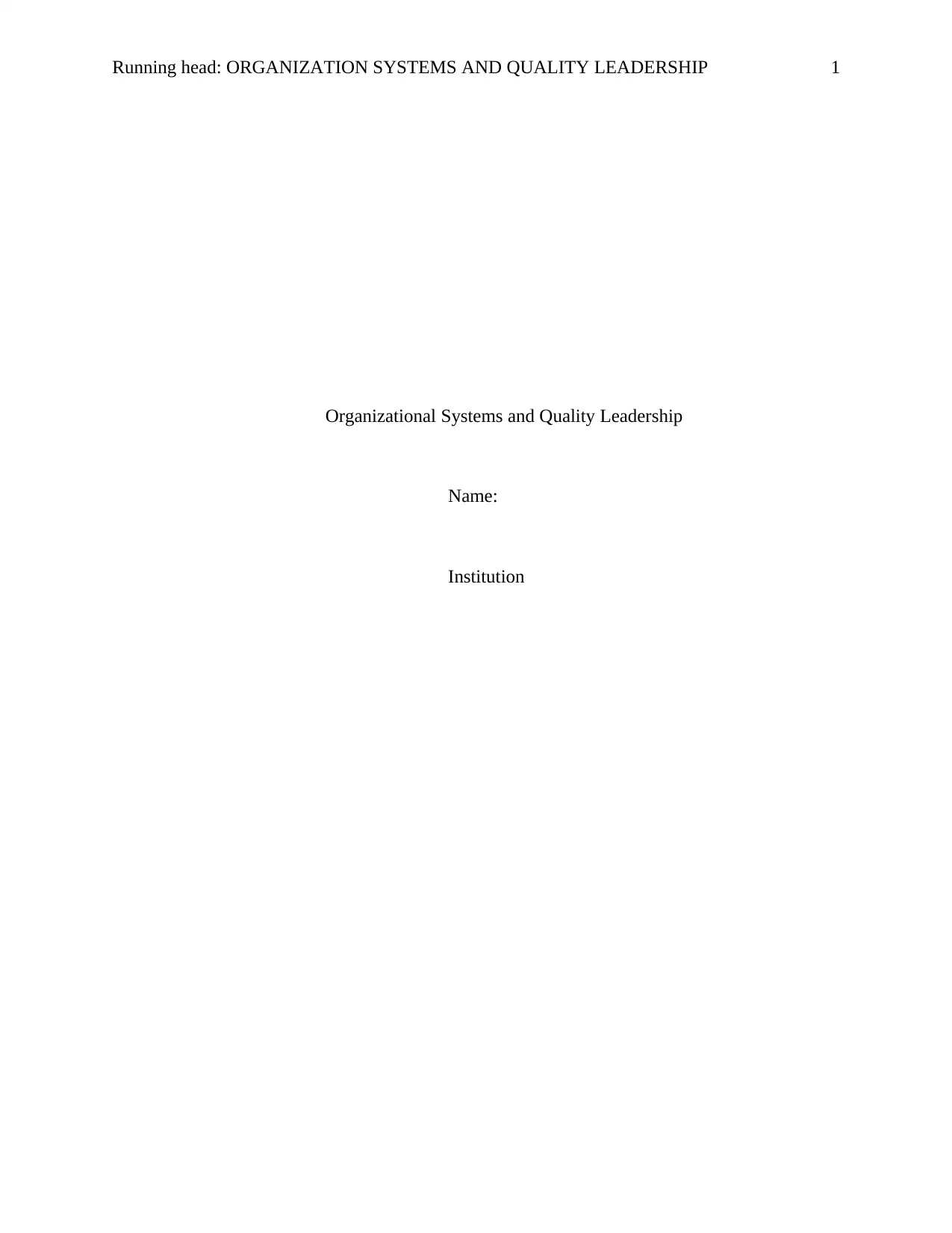
Running head: ORGANIZATION SYSTEMS AND QUALITY LEADERSHIP 1
Organizational Systems and Quality Leadership
Name:
Institution
Organizational Systems and Quality Leadership
Name:
Institution
Paraphrase This Document
Need a fresh take? Get an instant paraphrase of this document with our AI Paraphraser
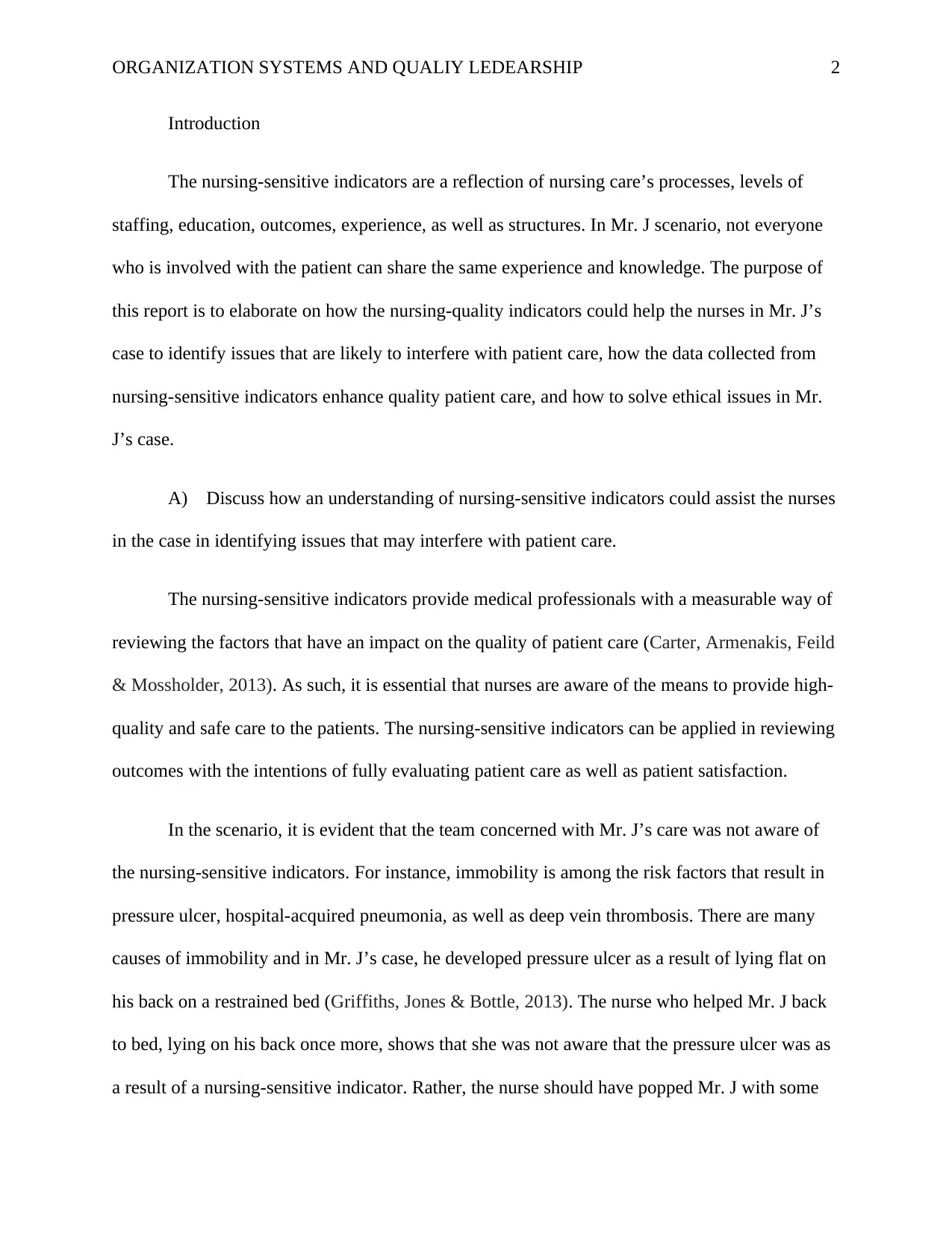
ORGANIZATION SYSTEMS AND QUALIY LEDEARSHIP 2
Introduction
The nursing-sensitive indicators are a reflection of nursing care’s processes, levels of
staffing, education, outcomes, experience, as well as structures. In Mr. J scenario, not everyone
who is involved with the patient can share the same experience and knowledge. The purpose of
this report is to elaborate on how the nursing-quality indicators could help the nurses in Mr. J’s
case to identify issues that are likely to interfere with patient care, how the data collected from
nursing-sensitive indicators enhance quality patient care, and how to solve ethical issues in Mr.
J’s case.
A) Discuss how an understanding of nursing-sensitive indicators could assist the nurses
in the case in identifying issues that may interfere with patient care.
The nursing-sensitive indicators provide medical professionals with a measurable way of
reviewing the factors that have an impact on the quality of patient care (Carter, Armenakis, Feild
& Mossholder, 2013). As such, it is essential that nurses are aware of the means to provide high-
quality and safe care to the patients. The nursing-sensitive indicators can be applied in reviewing
outcomes with the intentions of fully evaluating patient care as well as patient satisfaction.
In the scenario, it is evident that the team concerned with Mr. J’s care was not aware of
the nursing-sensitive indicators. For instance, immobility is among the risk factors that result in
pressure ulcer, hospital-acquired pneumonia, as well as deep vein thrombosis. There are many
causes of immobility and in Mr. J’s case, he developed pressure ulcer as a result of lying flat on
his back on a restrained bed (Griffiths, Jones & Bottle, 2013). The nurse who helped Mr. J back
to bed, lying on his back once more, shows that she was not aware that the pressure ulcer was as
a result of a nursing-sensitive indicator. Rather, the nurse should have popped Mr. J with some
Introduction
The nursing-sensitive indicators are a reflection of nursing care’s processes, levels of
staffing, education, outcomes, experience, as well as structures. In Mr. J scenario, not everyone
who is involved with the patient can share the same experience and knowledge. The purpose of
this report is to elaborate on how the nursing-quality indicators could help the nurses in Mr. J’s
case to identify issues that are likely to interfere with patient care, how the data collected from
nursing-sensitive indicators enhance quality patient care, and how to solve ethical issues in Mr.
J’s case.
A) Discuss how an understanding of nursing-sensitive indicators could assist the nurses
in the case in identifying issues that may interfere with patient care.
The nursing-sensitive indicators provide medical professionals with a measurable way of
reviewing the factors that have an impact on the quality of patient care (Carter, Armenakis, Feild
& Mossholder, 2013). As such, it is essential that nurses are aware of the means to provide high-
quality and safe care to the patients. The nursing-sensitive indicators can be applied in reviewing
outcomes with the intentions of fully evaluating patient care as well as patient satisfaction.
In the scenario, it is evident that the team concerned with Mr. J’s care was not aware of
the nursing-sensitive indicators. For instance, immobility is among the risk factors that result in
pressure ulcer, hospital-acquired pneumonia, as well as deep vein thrombosis. There are many
causes of immobility and in Mr. J’s case, he developed pressure ulcer as a result of lying flat on
his back on a restrained bed (Griffiths, Jones & Bottle, 2013). The nurse who helped Mr. J back
to bed, lying on his back once more, shows that she was not aware that the pressure ulcer was as
a result of a nursing-sensitive indicator. Rather, the nurse should have popped Mr. J with some
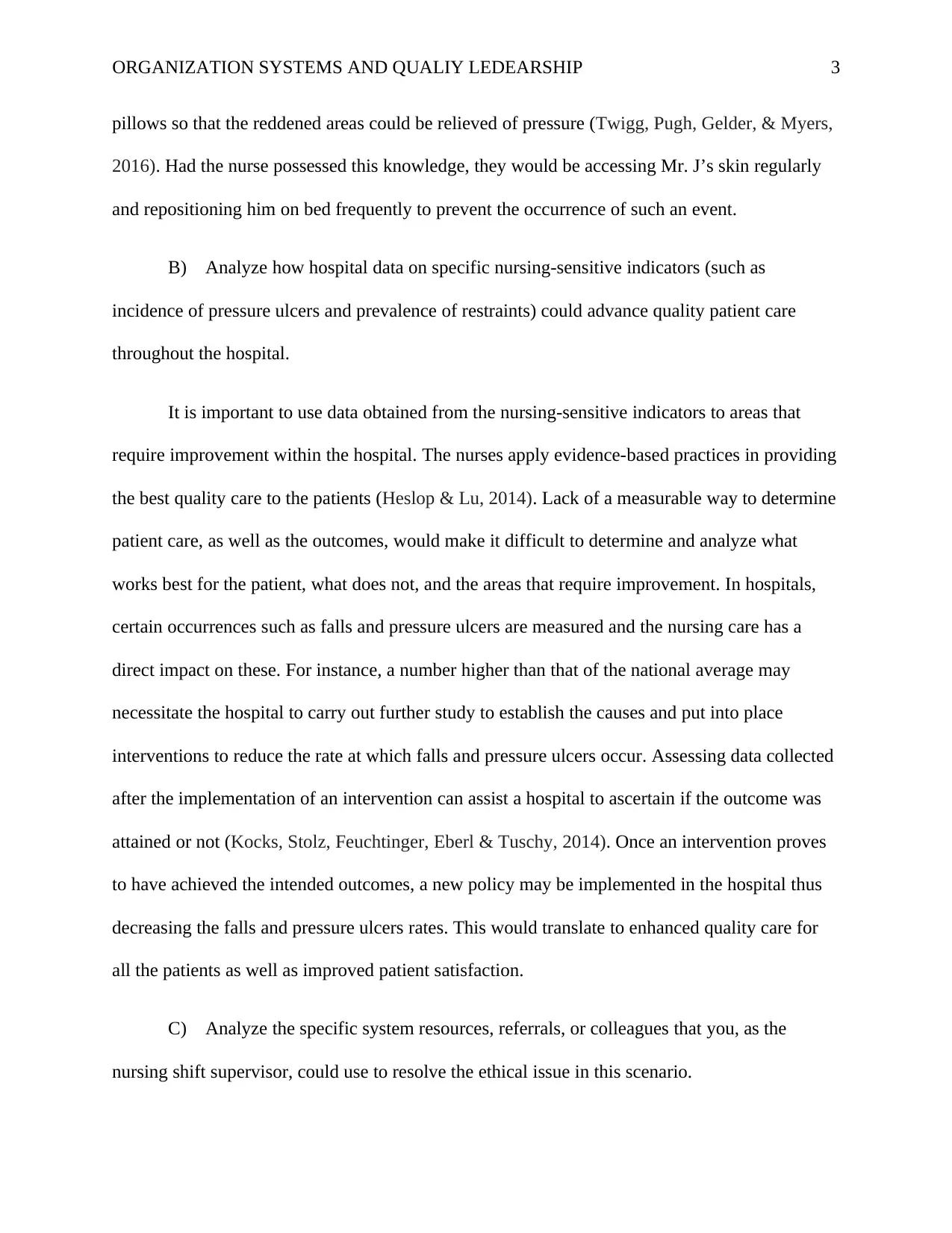
ORGANIZATION SYSTEMS AND QUALIY LEDEARSHIP 3
pillows so that the reddened areas could be relieved of pressure (Twigg, Pugh, Gelder, & Myers,
2016). Had the nurse possessed this knowledge, they would be accessing Mr. J’s skin regularly
and repositioning him on bed frequently to prevent the occurrence of such an event.
B) Analyze how hospital data on specific nursing-sensitive indicators (such as
incidence of pressure ulcers and prevalence of restraints) could advance quality patient care
throughout the hospital.
It is important to use data obtained from the nursing-sensitive indicators to areas that
require improvement within the hospital. The nurses apply evidence-based practices in providing
the best quality care to the patients (Heslop & Lu, 2014). Lack of a measurable way to determine
patient care, as well as the outcomes, would make it difficult to determine and analyze what
works best for the patient, what does not, and the areas that require improvement. In hospitals,
certain occurrences such as falls and pressure ulcers are measured and the nursing care has a
direct impact on these. For instance, a number higher than that of the national average may
necessitate the hospital to carry out further study to establish the causes and put into place
interventions to reduce the rate at which falls and pressure ulcers occur. Assessing data collected
after the implementation of an intervention can assist a hospital to ascertain if the outcome was
attained or not (Kocks, Stolz, Feuchtinger, Eberl & Tuschy, 2014). Once an intervention proves
to have achieved the intended outcomes, a new policy may be implemented in the hospital thus
decreasing the falls and pressure ulcers rates. This would translate to enhanced quality care for
all the patients as well as improved patient satisfaction.
C) Analyze the specific system resources, referrals, or colleagues that you, as the
nursing shift supervisor, could use to resolve the ethical issue in this scenario.
pillows so that the reddened areas could be relieved of pressure (Twigg, Pugh, Gelder, & Myers,
2016). Had the nurse possessed this knowledge, they would be accessing Mr. J’s skin regularly
and repositioning him on bed frequently to prevent the occurrence of such an event.
B) Analyze how hospital data on specific nursing-sensitive indicators (such as
incidence of pressure ulcers and prevalence of restraints) could advance quality patient care
throughout the hospital.
It is important to use data obtained from the nursing-sensitive indicators to areas that
require improvement within the hospital. The nurses apply evidence-based practices in providing
the best quality care to the patients (Heslop & Lu, 2014). Lack of a measurable way to determine
patient care, as well as the outcomes, would make it difficult to determine and analyze what
works best for the patient, what does not, and the areas that require improvement. In hospitals,
certain occurrences such as falls and pressure ulcers are measured and the nursing care has a
direct impact on these. For instance, a number higher than that of the national average may
necessitate the hospital to carry out further study to establish the causes and put into place
interventions to reduce the rate at which falls and pressure ulcers occur. Assessing data collected
after the implementation of an intervention can assist a hospital to ascertain if the outcome was
attained or not (Kocks, Stolz, Feuchtinger, Eberl & Tuschy, 2014). Once an intervention proves
to have achieved the intended outcomes, a new policy may be implemented in the hospital thus
decreasing the falls and pressure ulcers rates. This would translate to enhanced quality care for
all the patients as well as improved patient satisfaction.
C) Analyze the specific system resources, referrals, or colleagues that you, as the
nursing shift supervisor, could use to resolve the ethical issue in this scenario.
⊘ This is a preview!⊘
Do you want full access?
Subscribe today to unlock all pages.

Trusted by 1+ million students worldwide
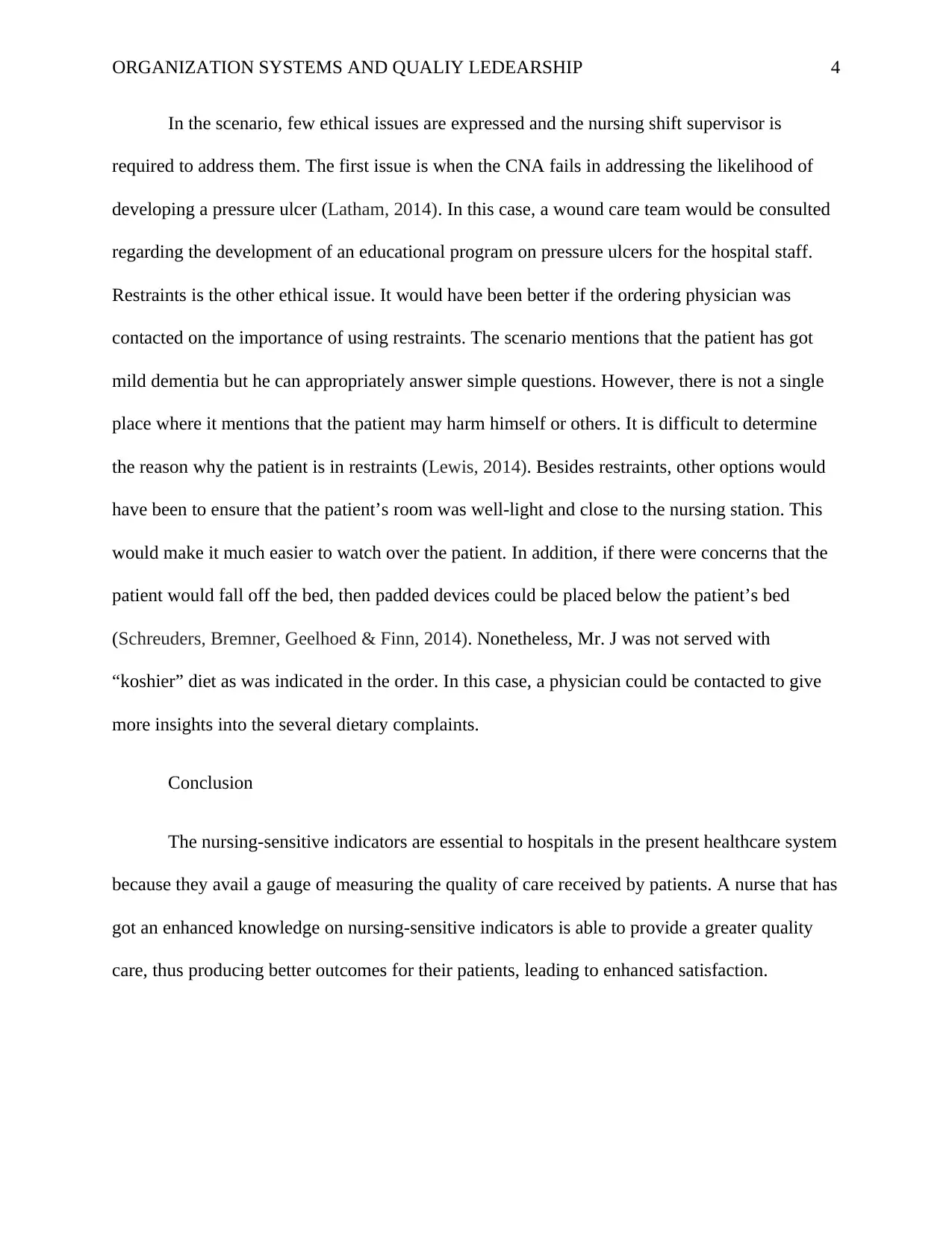
ORGANIZATION SYSTEMS AND QUALIY LEDEARSHIP 4
In the scenario, few ethical issues are expressed and the nursing shift supervisor is
required to address them. The first issue is when the CNA fails in addressing the likelihood of
developing a pressure ulcer (Latham, 2014). In this case, a wound care team would be consulted
regarding the development of an educational program on pressure ulcers for the hospital staff.
Restraints is the other ethical issue. It would have been better if the ordering physician was
contacted on the importance of using restraints. The scenario mentions that the patient has got
mild dementia but he can appropriately answer simple questions. However, there is not a single
place where it mentions that the patient may harm himself or others. It is difficult to determine
the reason why the patient is in restraints (Lewis, 2014). Besides restraints, other options would
have been to ensure that the patient’s room was well-light and close to the nursing station. This
would make it much easier to watch over the patient. In addition, if there were concerns that the
patient would fall off the bed, then padded devices could be placed below the patient’s bed
(Schreuders, Bremner, Geelhoed & Finn, 2014). Nonetheless, Mr. J was not served with
“koshier” diet as was indicated in the order. In this case, a physician could be contacted to give
more insights into the several dietary complaints.
Conclusion
The nursing-sensitive indicators are essential to hospitals in the present healthcare system
because they avail a gauge of measuring the quality of care received by patients. A nurse that has
got an enhanced knowledge on nursing-sensitive indicators is able to provide a greater quality
care, thus producing better outcomes for their patients, leading to enhanced satisfaction.
In the scenario, few ethical issues are expressed and the nursing shift supervisor is
required to address them. The first issue is when the CNA fails in addressing the likelihood of
developing a pressure ulcer (Latham, 2014). In this case, a wound care team would be consulted
regarding the development of an educational program on pressure ulcers for the hospital staff.
Restraints is the other ethical issue. It would have been better if the ordering physician was
contacted on the importance of using restraints. The scenario mentions that the patient has got
mild dementia but he can appropriately answer simple questions. However, there is not a single
place where it mentions that the patient may harm himself or others. It is difficult to determine
the reason why the patient is in restraints (Lewis, 2014). Besides restraints, other options would
have been to ensure that the patient’s room was well-light and close to the nursing station. This
would make it much easier to watch over the patient. In addition, if there were concerns that the
patient would fall off the bed, then padded devices could be placed below the patient’s bed
(Schreuders, Bremner, Geelhoed & Finn, 2014). Nonetheless, Mr. J was not served with
“koshier” diet as was indicated in the order. In this case, a physician could be contacted to give
more insights into the several dietary complaints.
Conclusion
The nursing-sensitive indicators are essential to hospitals in the present healthcare system
because they avail a gauge of measuring the quality of care received by patients. A nurse that has
got an enhanced knowledge on nursing-sensitive indicators is able to provide a greater quality
care, thus producing better outcomes for their patients, leading to enhanced satisfaction.
Paraphrase This Document
Need a fresh take? Get an instant paraphrase of this document with our AI Paraphraser
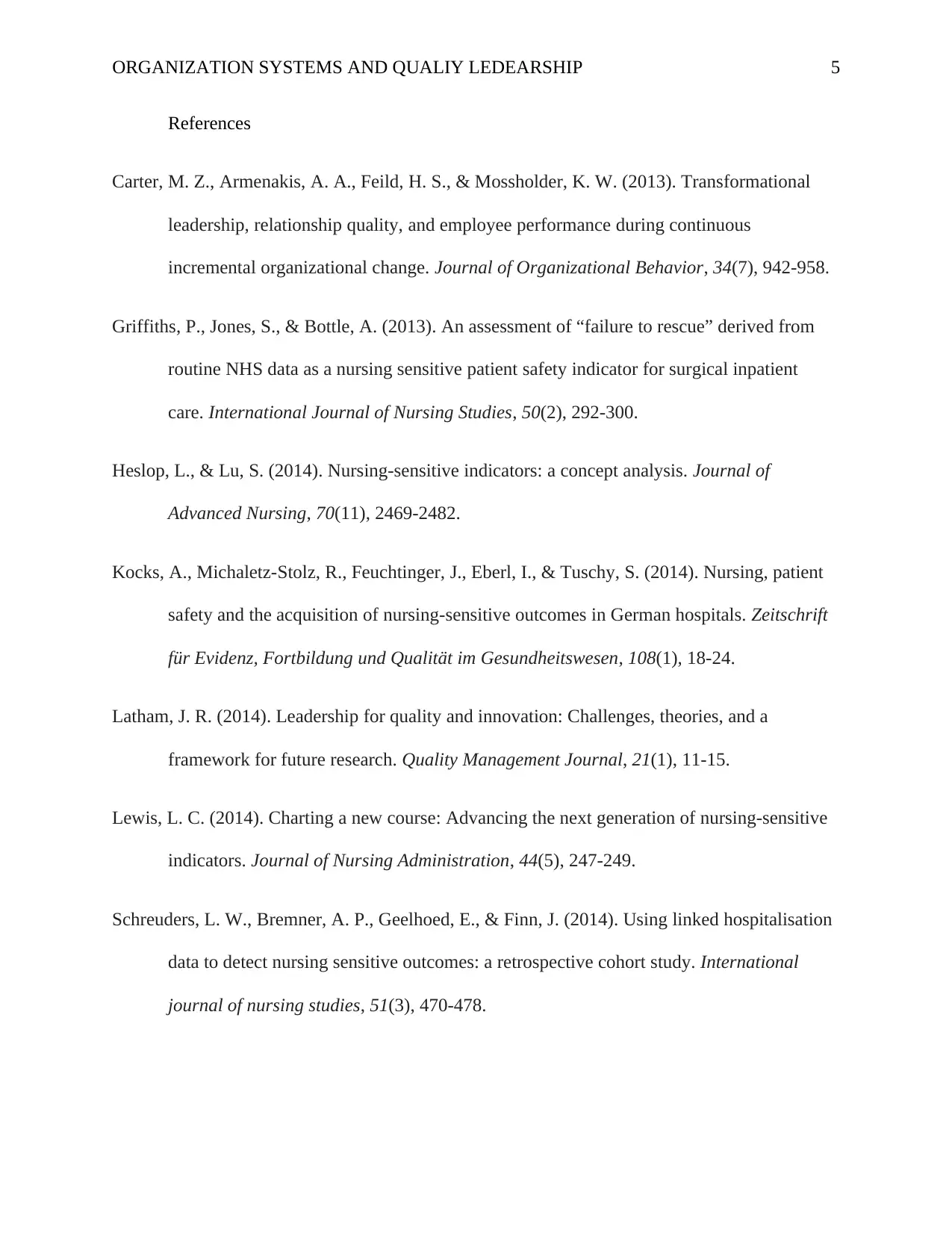
ORGANIZATION SYSTEMS AND QUALIY LEDEARSHIP 5
References
Carter, M. Z., Armenakis, A. A., Feild, H. S., & Mossholder, K. W. (2013). Transformational
leadership, relationship quality, and employee performance during continuous
incremental organizational change. Journal of Organizational Behavior, 34(7), 942-958.
Griffiths, P., Jones, S., & Bottle, A. (2013). An assessment of “failure to rescue” derived from
routine NHS data as a nursing sensitive patient safety indicator for surgical inpatient
care. International Journal of Nursing Studies, 50(2), 292-300.
Heslop, L., & Lu, S. (2014). Nursing‐sensitive indicators: a concept analysis. Journal of
Advanced Nursing, 70(11), 2469-2482.
Kocks, A., Michaletz-Stolz, R., Feuchtinger, J., Eberl, I., & Tuschy, S. (2014). Nursing, patient
safety and the acquisition of nursing-sensitive outcomes in German hospitals. Zeitschrift
für Evidenz, Fortbildung und Qualität im Gesundheitswesen, 108(1), 18-24.
Latham, J. R. (2014). Leadership for quality and innovation: Challenges, theories, and a
framework for future research. Quality Management Journal, 21(1), 11-15.
Lewis, L. C. (2014). Charting a new course: Advancing the next generation of nursing-sensitive
indicators. Journal of Nursing Administration, 44(5), 247-249.
Schreuders, L. W., Bremner, A. P., Geelhoed, E., & Finn, J. (2014). Using linked hospitalisation
data to detect nursing sensitive outcomes: a retrospective cohort study. International
journal of nursing studies, 51(3), 470-478.
References
Carter, M. Z., Armenakis, A. A., Feild, H. S., & Mossholder, K. W. (2013). Transformational
leadership, relationship quality, and employee performance during continuous
incremental organizational change. Journal of Organizational Behavior, 34(7), 942-958.
Griffiths, P., Jones, S., & Bottle, A. (2013). An assessment of “failure to rescue” derived from
routine NHS data as a nursing sensitive patient safety indicator for surgical inpatient
care. International Journal of Nursing Studies, 50(2), 292-300.
Heslop, L., & Lu, S. (2014). Nursing‐sensitive indicators: a concept analysis. Journal of
Advanced Nursing, 70(11), 2469-2482.
Kocks, A., Michaletz-Stolz, R., Feuchtinger, J., Eberl, I., & Tuschy, S. (2014). Nursing, patient
safety and the acquisition of nursing-sensitive outcomes in German hospitals. Zeitschrift
für Evidenz, Fortbildung und Qualität im Gesundheitswesen, 108(1), 18-24.
Latham, J. R. (2014). Leadership for quality and innovation: Challenges, theories, and a
framework for future research. Quality Management Journal, 21(1), 11-15.
Lewis, L. C. (2014). Charting a new course: Advancing the next generation of nursing-sensitive
indicators. Journal of Nursing Administration, 44(5), 247-249.
Schreuders, L. W., Bremner, A. P., Geelhoed, E., & Finn, J. (2014). Using linked hospitalisation
data to detect nursing sensitive outcomes: a retrospective cohort study. International
journal of nursing studies, 51(3), 470-478.
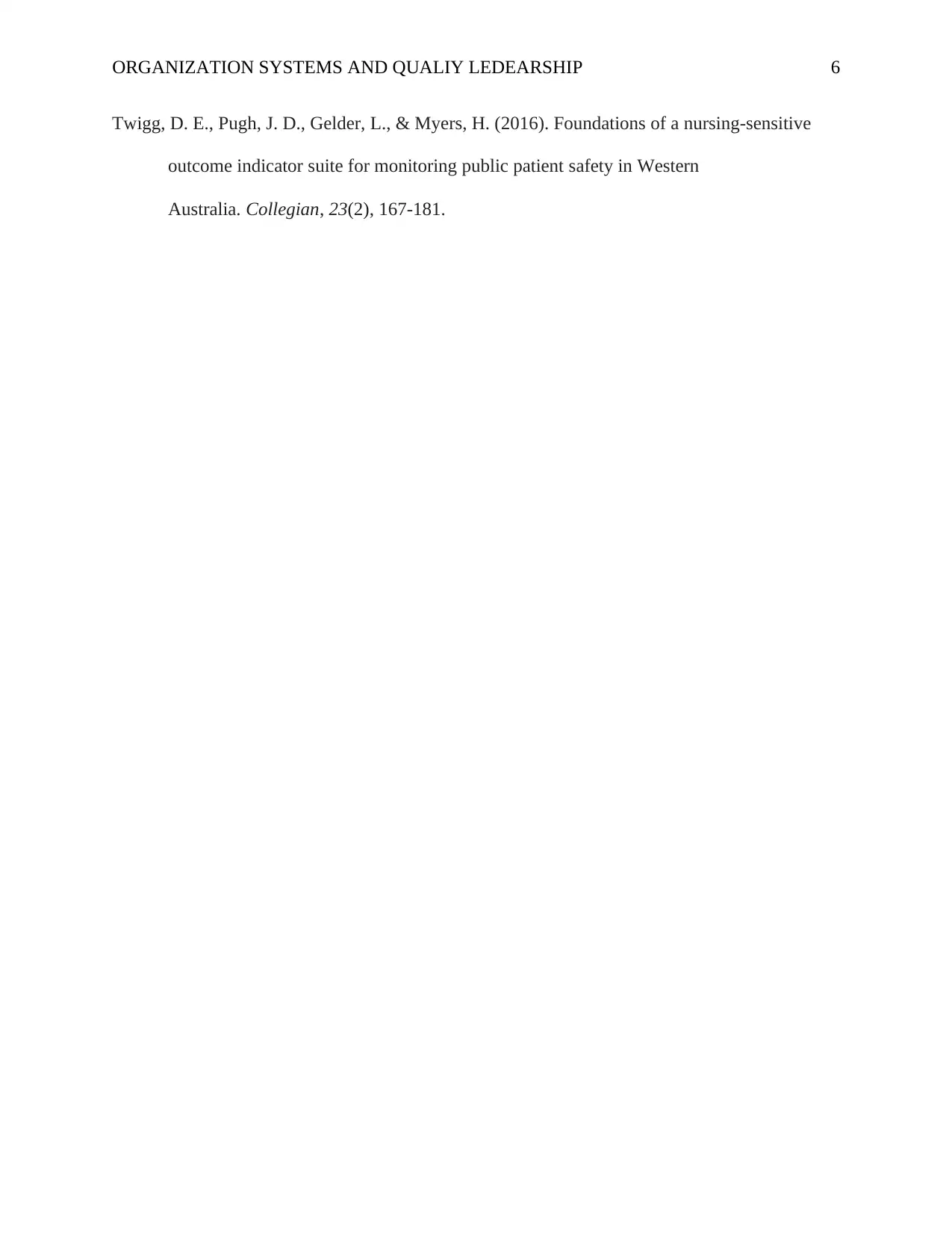
ORGANIZATION SYSTEMS AND QUALIY LEDEARSHIP 6
Twigg, D. E., Pugh, J. D., Gelder, L., & Myers, H. (2016). Foundations of a nursing-sensitive
outcome indicator suite for monitoring public patient safety in Western
Australia. Collegian, 23(2), 167-181.
Twigg, D. E., Pugh, J. D., Gelder, L., & Myers, H. (2016). Foundations of a nursing-sensitive
outcome indicator suite for monitoring public patient safety in Western
Australia. Collegian, 23(2), 167-181.
⊘ This is a preview!⊘
Do you want full access?
Subscribe today to unlock all pages.

Trusted by 1+ million students worldwide
1 out of 6
Related Documents
Your All-in-One AI-Powered Toolkit for Academic Success.
+13062052269
info@desklib.com
Available 24*7 on WhatsApp / Email
![[object Object]](/_next/static/media/star-bottom.7253800d.svg)
Unlock your academic potential
Copyright © 2020–2025 A2Z Services. All Rights Reserved. Developed and managed by ZUCOL.





